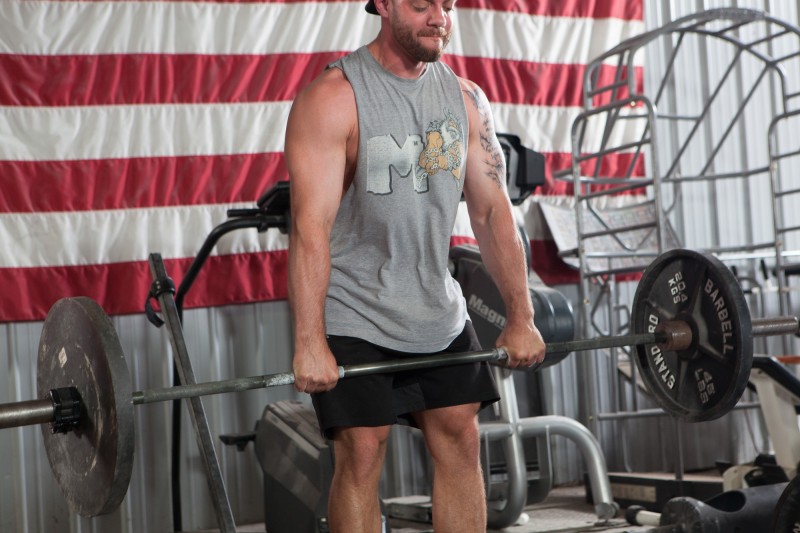
It can be easy for us to look at training programs through a very narrow lens, and neglect how life and training intersect. Training (and the recovery and nutrition that supports it) will be different for a lifter that sits at a desk than for a lifter who is carrying around steel beams at a construction site all day.
Now, does that mean that every person needs a super-special program? I don’t believe so, but all the factors that affect performance need to be taken into consideration when planning effective training. In a 24-hour day, most people are training 1-2 hours at most, and that’s typically not every day. What the rest of those hours consist of dramatically impacts performance, especially if 8-12 hours of the day is physically demanding work.
RECENT: The Art of Being an Emotionally Detached Strength Athlete
I have had several points in my life where I saw the contrast of differing lifestyles on training and programming. My current job is administrative and fairly sedentary (non-physical), but in the past, I have done manual concrete leveling, both full-time and then part-time on the weekends. In that job, the majority of the 8-12-hour day is spent picking up concrete slabs, moving buckets of gravel, chopping tree roots, and so on. When I was doing that job full-time several years ago, I was also preparing to compete in powerlifting at WPC Worlds, and I definitely had to make sure my training, recovery, and nutrition aligned. While the principles of my training philosophy remain the same no matter what job I have, how those principles are applied differs based on the situation. Because every reader’s situation will vary depending on the nature of their job, I’m outlining three key guidelines that will help you plan your training in the most effective way possible.
Don’t let being idealistic prevent you from being realistic.
It can be easy to be so focused on trying to make the “perfect” program work, that you neglect using the optimal program. Oftentimes, we try to emulate what a particular lifter or coach does, without making sure the context of the person using that program lines up with our own. Maybe in a perfect world you’d love to squat five times a week, but based on your lifestyle and recovery, is that optimal? If you are working 10-12 hours per day in a physically demanding job, have a family, and want to maximize your training, then you are going to have to be strategic (and even creative). It isn’t about making training easier; it’s about making sure your training program is designed in a way that your sessions can be done with consistency, and with maximal effort and quality.
Make sure your goals also align with your priorities. It isn’t my place to judge either one, but what I will say is that you need to make sure that they align in order to be successful. Don’t pick a goal that requires something on your priority list to be number one, when it’s really number four. Not only will that prevent you from accomplishing your goal, but it will negatively affect your other priorities in life as you wrestle with this misalignment. This is something that we could discuss much further (and I may do so in a separate article), but my biggest advice here is to make sure, before you tackle any challenge, that you sit down and gain clarity on your values, priorities, and goals.
Making sure that your goals and expectations for each individual session are realistic is equally important. The more fatigue you accumulate throughout the week at work, the less chance you’re going to be at peak strength in any one training session (this is the case even for those that don’t work physical jobs). If you do max effort work as part of training, make sure you remember that it’s a max effort movement, and not an “all-time competition PR” movement. The benefit of max effort work is that it’s relative to your current capacity. If using a percentage-based program, I always suggest using a low training max (85-90% of actual max) to base your percentages off of. A training max helps account for the fluctuations in recovery, fatigue, and other factors (while still keeping you on track in your program).
Align your training sessions with your work demands.
While the day-to-day physical demands of your job may vary, it is important to sit down and evaluate what exactly those physical demands look like, and then make sure your training fits accordingly. For example, does your work day consist of walking at a sustained pace carrying light bags of equipment? Or is it more of a sporadic, high-intensity activity such as chopping out large tree stumps at a few separate jobs throughout the day? Evaluating what muscle groups are being used is also helpful to recognize, because if you’re carrying around 100-pound buckets all day (basically doing farmer’s walks), you probably don’t need to be doing dumbbell shrugs in the gym.
Remember: it’s all about optimizing your time in the gym and the energy that you have outside of work. If you use your upper back constantly throughout the day at work lifting things, you will want to focus more movements in training on other muscle groups that get neglected. The same goes for if you’re constantly doing pushing movements at work – make sure you perform enough rows and back movements to build strength and prevent injury and imbalance. The bottom line is: do what you need to do, cut out what you don’t.
In my case, I was doing a lot of sporadic moderate or heavy carries (buckets of gravel) throughout the day, and constantly moving and lifting light loads (i.e. using crowbars to manipulate concrete slabs, carrying lighter tools, sawing concrete, etc.) during the times in between. This did a great job providing me with more work capacity and muscular endurance, but it also sapped my energy and put additional demands on recovery and nutrition (which we’ll talk about next). For my time in the gym, I knew I didn’t need to spend two hours doing a ton of volume (and if I did, I was going to burn myself out pretty quickly). Instead, I focused on keeping training simple, focusing on a limited number of movements that had the most bang-for-their-buck.
Since the constant light-moderate movement throughout the day at work consistently contributed to a foundation of general conditioning and strength, I focused on a “top” set with an accompanying moderate percentage and goal, versus multiple higher-rep, low-percentage sets. For example, working up to a set of as many reps as possible with 85 percent, instead of three sets of ten at 75 percent. Especially with the accumulation of fatigue from work, the risk of technique breaking down and injury occurring is higher as the training session goes on. Limiting the number of high-rep sets and instead focusing on one top “+” set (such as is utilized in 5/3/1), or multiple sets of lower repetitions (i.e. 8 sets of 2) are strategies to accommodate this. All other movements in the session were based on developing traits that the physical demands of work didn’t address (such as speed and technique), and performing assistance work that would aid in recovery, develop weaknesses, and prevent injury (lots of reverse hypers). The exact components of your training program will vary depending on what your training philosophy is, but the key takeaways here are to:
- Realistically assess the physical demands of your job.
- Make training as efficient and productive as possible, maximizing your time and energy, and fitting within the context of your job demands.
Recognize that you have very little margin for error with recovery.
When you deal with consistently high levels of stress, whether it be from the physical stress of a labor job, or the mental stress of owning a business, the need to train smarter increases. Something that I emphasize when it comes to programming for those with mental health issues is that people who are under high levels of emotional stress don’t need a special program, but their margin for error is much smaller in a normal program. When recovery and stress management is great, you can recover from training “stupid” easier (even when it isn’t optimal), but when those reserves are depleted, a couple stupid training sessions could send you in a downward spiral of burnout. The same goes for the physical stress demands of your job and how they interact with training. This is why the expectations and alignment of training that I discussed earlier are so important. Consider the big picture, the context of your training, and stick to the plan without getting caught up in the emotions of training (see my last article for more on this). It will allow you to utilize certain aspects of your job to benefit training, instead of allowing it to derail you from your goals.
Lastly, make sure the other components of your recovery (particularly nutrition and sleep) support the combined physical demands of work and training. These are not my areas of expertise, so I won’t go too in-depth on either topic. The important thing is to make sure that your nutrition fuels your physical work, and that you are strategic in your nutrition planning to accommodate schedule or time challenges. Skipping meals or eating low-quality foods because you’re rushing between jobs will come back to bite you in training performance. Lack of quality sleep (see this article) will also impact your performance and ability to train, so make sure these areas are not neglected as you pursue your goals.
Training while working a physical job can be challenging, but it isn’t impossible. Be realistic, strategize, and be proactive in all areas that affect performance. Work as smart as you work hard, and nothing will stop you from achieving your goals.
Header image credit: Thodsapol Thongdeekhieo © 123rf.com












Awesome article I move furniture all day so this really helped me think about how that effects my training! I carry heavy sleeper sofas to concrete tables so it makes for an exhausting day sometimes.